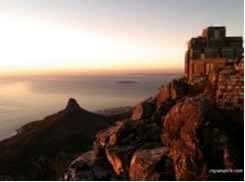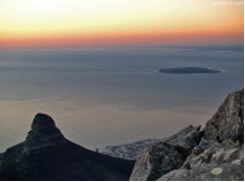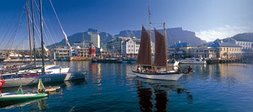Cape Town Winter

Table Mountain
Cape Town Winter

Table Mountain / Robben Island
Thursday, June 21, 2007
People of the Cape
KHOISAN
People have lived in the Cape for thousands of years. Small groups of nomadic hunter-gatherers (San) and pastoralists (Khoikhoi) are collectively known as the Khoisan. Colonial conquests, smallpox and perpetual racism have all but decimated the only real indigenous people of the Cape. Many intermarried with slaves and others to form the “Cape Coloured” people. Small numbers of “authentic” Khoisan remain today, living in the traditional manner in the Northern Cape.
AFRICAN
Ancestors of the amaXhosa moved south from the Great Lakes around 1500 years ago. More recently, West African slaves were brought to the Cape during the 17th and 18th centuries. Since 1994 South Africa’s borders have opened up and people from all over the continent have flocked here in search of opportunities and a better life.
PORTUGUESE
The earliest European sightings of the Cape were by Portuguese explorers Bartolomeu Dias and Vasco Da Gama at the end of the 15th century. In 1503, Antonio de Saldanha became the first European to land in Table Bay. Later, in 1658, a Portuguese slave vessel carrying 170 slaves arrived at the Cape. In the 1960s and 70s, a wave of Portuguese settlers came to the Cape, fleeing wars in Portuguese colonies Angola and Mozambique.
DUTCH
In 1647, shipwrecked Dutch sailors built a small fort and upon their return to Holland a year later, they persuaded the Dutch East India Company (VOC) to establish a post here. In 1652, a Dutch expedition of 90 Calvinist settlers led by Jan van Riebeeck founded the first permanent settlement here. From 1672, the Cape had a Governor of its own but remained under Dutch control until 1795.
FRENCH
The first non-Dutch immigrants to the Cape were the French Huguenots, the majority of whom arrived in 1688 and 1689. Fleeing anti-Protestant persecution in Catholic France, the VOC subsidized their emigration to the Cape because of their shared religious beliefs and desirable skills. Owing to VOC language restrictions instituted in 1701, the French Huguenots ceased by the middle of the 18th century to maintain a distinct identity and language.
MUSLIM & INDIAN
The first Muslims arrived as slaves and political exiles from the Dutch colonies of Java and Malaysia in the 1650s, with many banished to Robben Island. A second wave of Muslims were brought here by Britain from India in the 1860s. Many Hindu Indians served as auxiliaries in the Anglo-Boer War and settled here afterward.
BRITISH
Ever since Sir Francis Drake in 1580 dubbed this “the fairest Cape in the whole circumference of the earth”, Britain has maintained a healthy interest in the Cape, finally consolidating their rule in 1814. In 1820, British authorities persuaded 5000 middle-class immigrants to leave England and settle on strategic land in the Cape. Within three years, almost half of these 1820 Settlers had retreated to the towns, particularly Grahamstown and Port Elizabeth. Today, British influence in the Cape is everywhere, even in the smallest Karoo town.
OTHERS
Jewish settlers from England and Eastern Europe, particularly Lithuania and Latvia, Germans, who have established a number of schools here and Filipinos who arrived from a shipwreck in the mid-1840s are just some of the minority ethnic groups that have added to the Cape’s vibrant cultural mix.
People have lived in the Cape for thousands of years. Small groups of nomadic hunter-gatherers (San) and pastoralists (Khoikhoi) are collectively known as the Khoisan. Colonial conquests, smallpox and perpetual racism have all but decimated the only real indigenous people of the Cape. Many intermarried with slaves and others to form the “Cape Coloured” people. Small numbers of “authentic” Khoisan remain today, living in the traditional manner in the Northern Cape.
AFRICAN
Ancestors of the amaXhosa moved south from the Great Lakes around 1500 years ago. More recently, West African slaves were brought to the Cape during the 17th and 18th centuries. Since 1994 South Africa’s borders have opened up and people from all over the continent have flocked here in search of opportunities and a better life.
PORTUGUESE
The earliest European sightings of the Cape were by Portuguese explorers Bartolomeu Dias and Vasco Da Gama at the end of the 15th century. In 1503, Antonio de Saldanha became the first European to land in Table Bay. Later, in 1658, a Portuguese slave vessel carrying 170 slaves arrived at the Cape. In the 1960s and 70s, a wave of Portuguese settlers came to the Cape, fleeing wars in Portuguese colonies Angola and Mozambique.
DUTCH
In 1647, shipwrecked Dutch sailors built a small fort and upon their return to Holland a year later, they persuaded the Dutch East India Company (VOC) to establish a post here. In 1652, a Dutch expedition of 90 Calvinist settlers led by Jan van Riebeeck founded the first permanent settlement here. From 1672, the Cape had a Governor of its own but remained under Dutch control until 1795.
FRENCH
The first non-Dutch immigrants to the Cape were the French Huguenots, the majority of whom arrived in 1688 and 1689. Fleeing anti-Protestant persecution in Catholic France, the VOC subsidized their emigration to the Cape because of their shared religious beliefs and desirable skills. Owing to VOC language restrictions instituted in 1701, the French Huguenots ceased by the middle of the 18th century to maintain a distinct identity and language.
MUSLIM & INDIAN
The first Muslims arrived as slaves and political exiles from the Dutch colonies of Java and Malaysia in the 1650s, with many banished to Robben Island. A second wave of Muslims were brought here by Britain from India in the 1860s. Many Hindu Indians served as auxiliaries in the Anglo-Boer War and settled here afterward.
BRITISH
Ever since Sir Francis Drake in 1580 dubbed this “the fairest Cape in the whole circumference of the earth”, Britain has maintained a healthy interest in the Cape, finally consolidating their rule in 1814. In 1820, British authorities persuaded 5000 middle-class immigrants to leave England and settle on strategic land in the Cape. Within three years, almost half of these 1820 Settlers had retreated to the towns, particularly Grahamstown and Port Elizabeth. Today, British influence in the Cape is everywhere, even in the smallest Karoo town.
OTHERS
Jewish settlers from England and Eastern Europe, particularly Lithuania and Latvia, Germans, who have established a number of schools here and Filipinos who arrived from a shipwreck in the mid-1840s are just some of the minority ethnic groups that have added to the Cape’s vibrant cultural mix.
Subscribe to:
Post Comments (Atom)


No comments:
Post a Comment